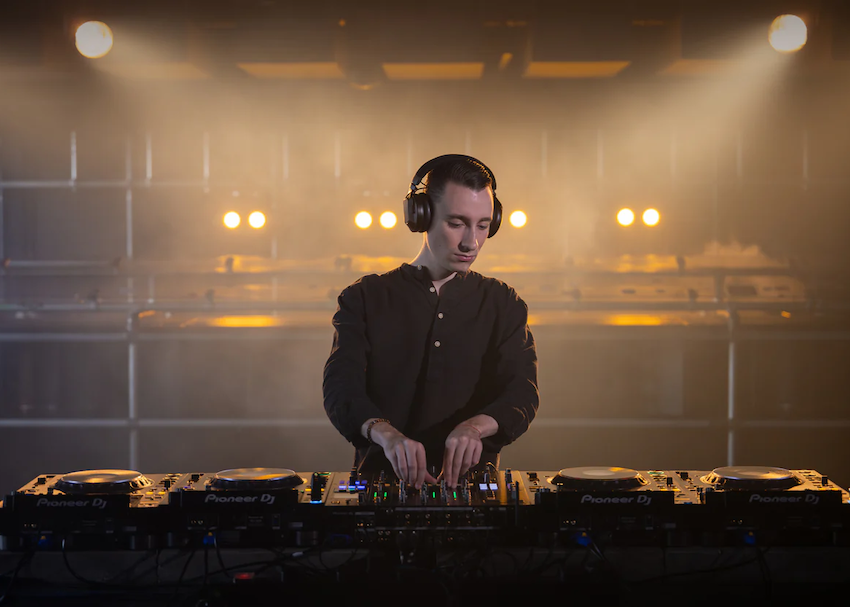If you’ve ever tried to DJ or play an instrument while monitoring your performance on Bluetooth wireless headphones, you’ve likely run into latency issues. That’s why wired headphones have long been the standard for DJing or any monitoring application that requires precise timing. But now that ultra-low-latency wireless headphones like the AIAIAI TMA-2 DJ Wireless, AlphaTheta HDJ-F10, and Yamaha YH-WL500 are hitting the market, DJs and musicians have a new way to break free from cables.
Read on to learn about audio latency and how these new headphones are minimizing it, along with more ideas for going ultra-low-latency, including wireless in-ear monitor rigs and the Boss Waza-Air systems for guitarists.
What is Audio Latency, and Why is it a Problem?
In the audio gear world, latency refers to the lag time, typically measured in milliseconds, between when you take an action (like playing a keyboard key or hitting a pad to trigger a sample) and when you hear the corresponding audio.
Any device that converts analog audio to digital audio (like a digital mixer, or a guitar processor with digital effects) introduces some latency, because those conversion processes take time. A key spec for audio interfaces is roundtrip latency — the amount of time it takes a signal to pass from the input through the A/D converter, into your computer’s DAW software, back out of the DAW, out of the D/A converter, and through to the output of your audio interface to your headphones or speakers.
When latency is too high, it becomes distracting to musicians and DJs, because you’ll hear the sound of your instrument, or the track you’re playing, slightly after you play it.
How Much Audio Latency is Acceptable?
Some listeners are more sensitive to latency than others, but on average, human ears don’t notice delays shorter than about 10 milliseconds. The human threshold of perceiving audio latency usually falls in the 10-15 ms range, and ~10 ms of latency is considered acceptable.
Once you’re above that 10 to 15 ms threshold, as latency increases, you’ll begin to notice an obvious lag between when you trigger a sound and when you hear it.
To put this in perspective, consider that the speed of sound through air is 1,100 feet per second, which means sound travels at roughly ~1 foot per millisecond. So if you’re standing 12 feet away from your guitar amp with a cable plugged in, the sound of your guitar is reaching your ears on roughly a 12-millisecond delay.
The speed of sound is much slower than the speed of light, and this becomes more and more apparent as a sound source gets farther away from your ears and eyes. Marching band performers must learn to use their eyes to track the movements of the drum major, rather than relying solely on the sound of the drums to march and play in time. Even in a symphony orchestra, the musicians in the back rows actually have to “lean ahead” of the beat, in order to stay in time with those in the front.
Why You Can’t Use Bluetooth Headphones for DJing
Audio signals travel through wires fast — basically instantaneously. (It’s never quite at the speed of light in a vacuum, but it’s going to be around 80% of light speed, which is still pretty dang fast. Great Scott!) Any latency introduced by audio cables themselves is completely negligible, and wired headphones have long been the standard for low-latency listening. But what about wireless headphones?
Bluetooth wireless audio codecs, especially the highest-audio-quality codecs, introduce around 40 to 250 milliseconds of latency — much higher than that 10-15 ms threshold that humans can detect. Even Qualcomm’s so-called aptX “Low Latency” protocol has a latency of approximately 40 milliseconds, according to the aptX website. And the more universal SBC Bluetooth protocols are even slower.
If you’re a casual video gamer wearing Bluetooth headphones, 40 thousandths of a second may be a perfectly acceptable lag time between hitting a button and hearing its effect (boom! headshot!), but for DJs or musicians, it’s far too long of a lag. Precise timing is key to beatmatching or triggering samples — a few milliseconds can make all the difference. And that’s why Bluetooth wireless headphones are typically not usable for studio or live applications.
If your goal is to eliminate latency, there still isn’t a substitute for wired headphones — or is there?
Meet the Ultra-Low-Latency Headphones!
Get in, we’re going wireless headphones shopping! And we’re putting each latency spec in bold so you can compare them easily here. For the purposes of this blog post, we’re going to define “ultra-low latency” as anything under 10 milliseconds.
(Another term you’ll hear bandied about is “near-zero latency,” which is rather meaningless, because it turns out that 10 milliseconds and 50 milliseconds are both very “near” to zero seconds — but 10 ms is going to make you happy while 50 ms might make you want to throw your headphones out the window.)
Ultra-Low-Latency AIAIAI Headphones:
At the 2025 NAMM Show, AIAIAI showed off their TMA-2 DJ Wireless headphones model, which they expect to release in spring 2025. “I am excited to say that we now have tech that gets the latency under 10ms — 9.7ms consistent — and also allows for higher decibel levels,” says AIAIAI’s Dave Hillel. The soon-to-be-released TMA-2 DJ Wireless headphones come with AIAIAI’s new X03 transmitter, which will use a version of their proprietary W+ Link wireless protocol that hits the sub-10ms benchmark thanks to some “very light” compression, according to AIAIAI.
If you’re in the studio, doing critical listening that requires uncompressed audio, and you want to go wireless, AIAIAI’s TMA-2 Studio Wireless Plus headphones offer uncompressed 44.1 kHz/16-bit audio via W+ Link at 16 ms latency. Which is still fast enough to be undetectable for many users, especially if you’re primarily using these cans for the many audio editing/mixing/production tasks that don’t involve performing in real time.
Ultra-Low-Latency AlphaTheta Headphones:
Going toe-to-toe with AIAIAI for ultra-low-latency wireless DJ headphones is none other than AlphaTheta, the industry giant behind the Pioneer DJ brand. They report 9 ms of latency for the AlphaTheta HDJ-F10 wireless headphones and HP-TX01 transmitter, which use their proprietary SonicLink wireless protocol. (It’s the same low-latency wireless technology that AlphaTheta deployed in their Wave-Eight powered speakers.)
Pro tip: high-end AlphaTheta decks like the XDJ-AZ come with a SonicLink transmitter built in. So if you’ve shelled out for an AlphaTheta XDJ-AZ, you don’t need to also buy the HP-TX01 transmitter box — you can just get the AlphaTheta HDJ-F10 headphones sans the transmitter.
Ultra-Low-Latency Yamaha Headphones:
Yamaha boasts under 4 ms of latency for the Yamaha YH-WL500 headphones, which come with their proprietary transmitter. How they achieved this is a secret, but Yamaha touts these headphones as “specifically voiced for musical instruments,” which could mean that there’s some audio compression/compounding going on, or some trimming of the frequency response of the signal that’s being transmitted, or some other audio witchcraft that only Yamaha knows how to do.
Guitarists: Check Out Boss Waza-Air
While we’re talking low-latency headphones for musicians, we would be remiss not to mention the Boss Waza-Air (and Waza-Air Bass) wireless personal guitar monitoring systems. The Boss Waza-Air systems come with a pair of wireless headphones and a transmitter called the WL-T, which you plug into the 1/4″ TS output on your guitar/bass.
According to Boss, the Waza-Air systems use the wireless tech from the Boss WL Wireless series, which run on the 2.4 GHz band and boast a latency of just 2.3 milliseconds.
If you’re looking for an easy way to practice guitar/bass silently, in wireless headphones, with undetectable latency (and while playing through Boss effects and amp models, of course!), this is it!
However, Boss Waza-Air systems are not set up to be used as wireless headphones for DJing or music production. The transmitter is sending a mono, not stereo, signal. While the Waza-Air’s WL-T transmitter has a 1/4″ TRS plug that looks like the stereo plug on a pair of wired headphones, it’s not intended to be plugged into the headphone output on a DJ mixer, audio interface, etc. That’s because the WL-T uses its Tip/Sleeve conductors for hot/ground, while the Ring conductor is for pairing and charging. So, plug it into your guitar/bass’s output jack and rock on.
What About In-Ear Monitor Systems?
Wireless in-ear monitors, or IEMs, are used by pro performers every day to hear themselves and others on stage with minimal latency. Since you’ll need to wear the IEM bodypack receiver with a pair of wired headphones/earphones plugged into it, your setup will be a bit clunkier than with the headphones listed above. But if latency is your number one concern, this is one way to eliminate it.
For example, Sennheiser’s XSW IEM SET is a solid mid-priced option for stereo wireless IEMs. Because it’s an analog wireless system — that is, it doesn’t convert audio from analog to digital — its latency is negligible, and comparable to wearing wired headphones. It also runs on the UHF band, which means it won’t be subject to 2.4 GHz interference. To feed the XSW transmitter with the stereo signal from your rig’s headphone jack, you’ll need a stereo 1/4″ TRS to two mono 1/4″ TS adapter, like the Hosa STP-200 series cables.
Though all digital wireless systems do add a few milliseconds of latency due to A/D and D/A conversion, their latency falls well within the undetectable range. After all, these wireless systems are designed to be used for live performance. For example, the Xvive U4 system lists its latency as 5 milliseconds.
A few caveats: the Xvive U4 is a mono only system, so you won’t be able to monitor in stereo, even if you’re using stereo headphones with a stereo TRS plug — the Xvive simply sends the same mono signal to both ears. And the Xvive U4 doesn’t include earphones, so you’ll need to plug your own wired earphones/headphones into the U4R bodypack receiver’s 1/8″ stereo output. Then plug the Xvive U4T transmitter into the headphone output of your DJ mixer, keyboard, guitar modeler, e-drum kit, etc.
2.4 GHz: Is it Crowded in Here or What?
The ultra-low-latency wireless protocols we’ve discussed in this blog post — AIAIAI’s W+ Link, AlphaTheta’s SonicLink, Yamaha’s proprietary system — all work by transmitting digital audio signals via radio frequency waves in the 2.4 GHz band.
The radio frequency waves themselves add no detectable latency; electromagnetic waves (whether they’re UHF, VHF, 2.4 GHz, 5.8 GHz, or any other frequency band) all travel at the speed of light through the air. The specific amount of audio latency in all of these systems depends on the speed of the encoding/decoding of the audio signal, including any analog-to-digital conversion or digital-to-analog conversion.
It’s worth pointing out that regular old high-latency Bluetooth also operates via 2.4 GHz waves. So do most Wi-Fi networks. So do many consumer devices, like baby monitors. And for that matter, so do a whole lot of wireless IEMs, wireless microphones, and wireless guitar systems used on stage. It’s a crowded part of the radio frequency spectrum.
Since 2.4 GHz devices can be subject to interference from other 2.4 GHz devices, you might run into trouble if you’re running two or more of them in close proximity to each other. You’ll know when you start hearing that tell-tale “bup-bup-bup” interference in your wireless headphones. And you’ll probably want to keep your trusty old wired headphones around as a backup — just in case!




Leave a Reply